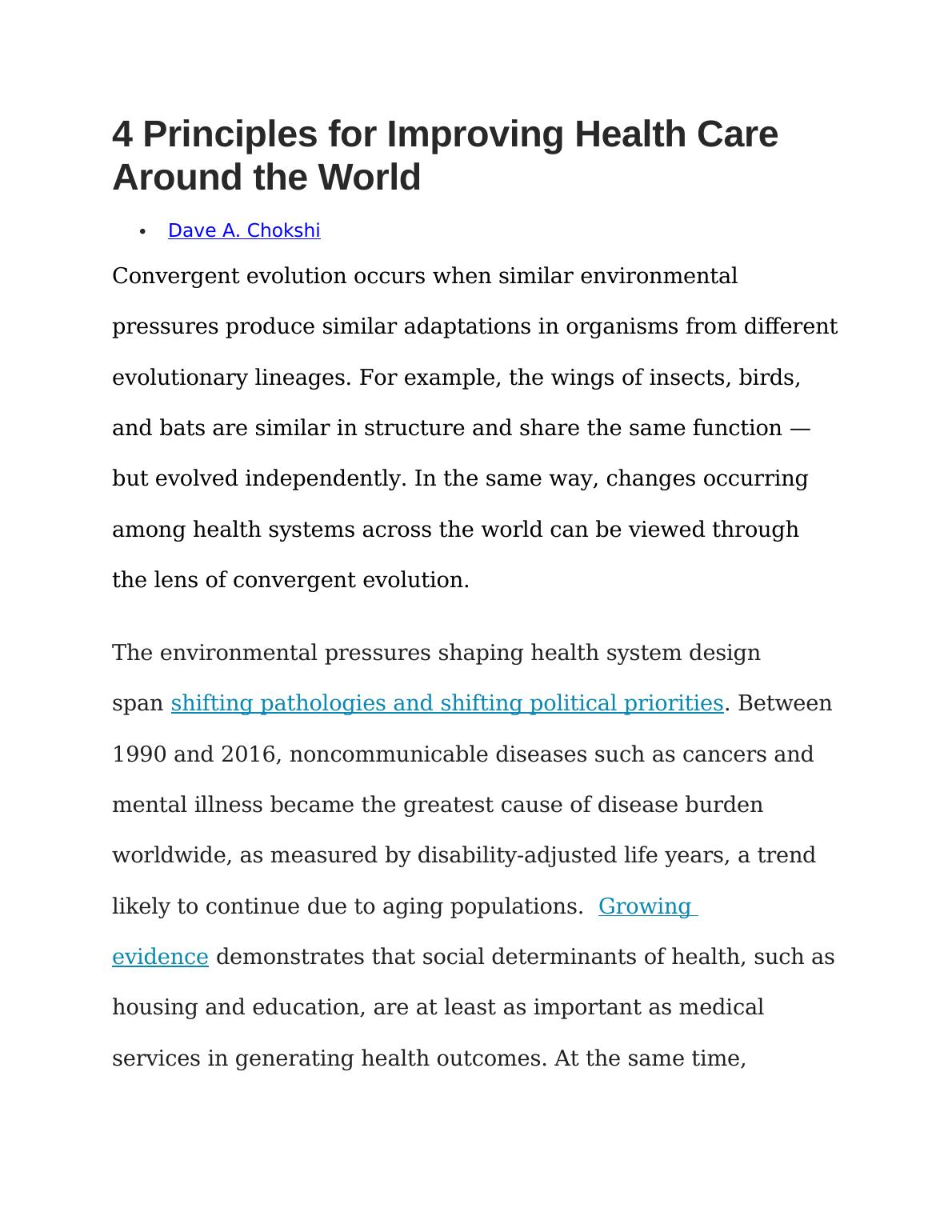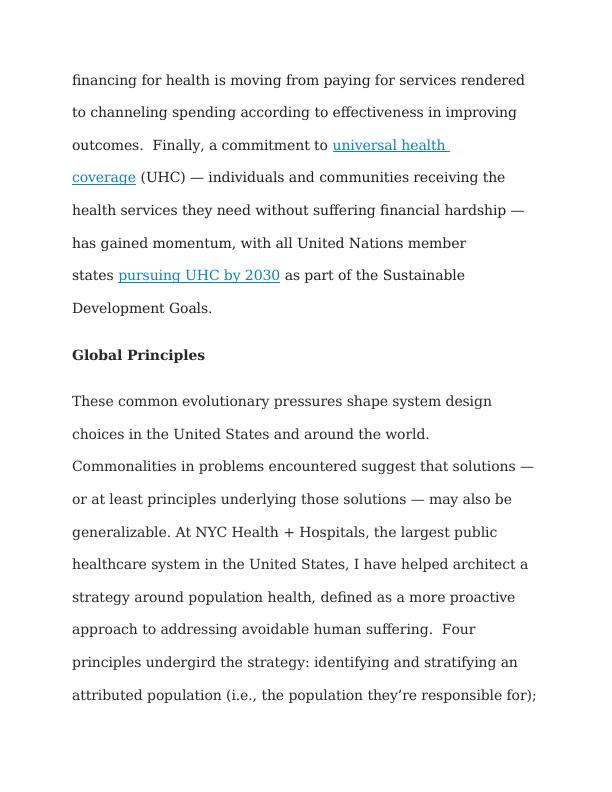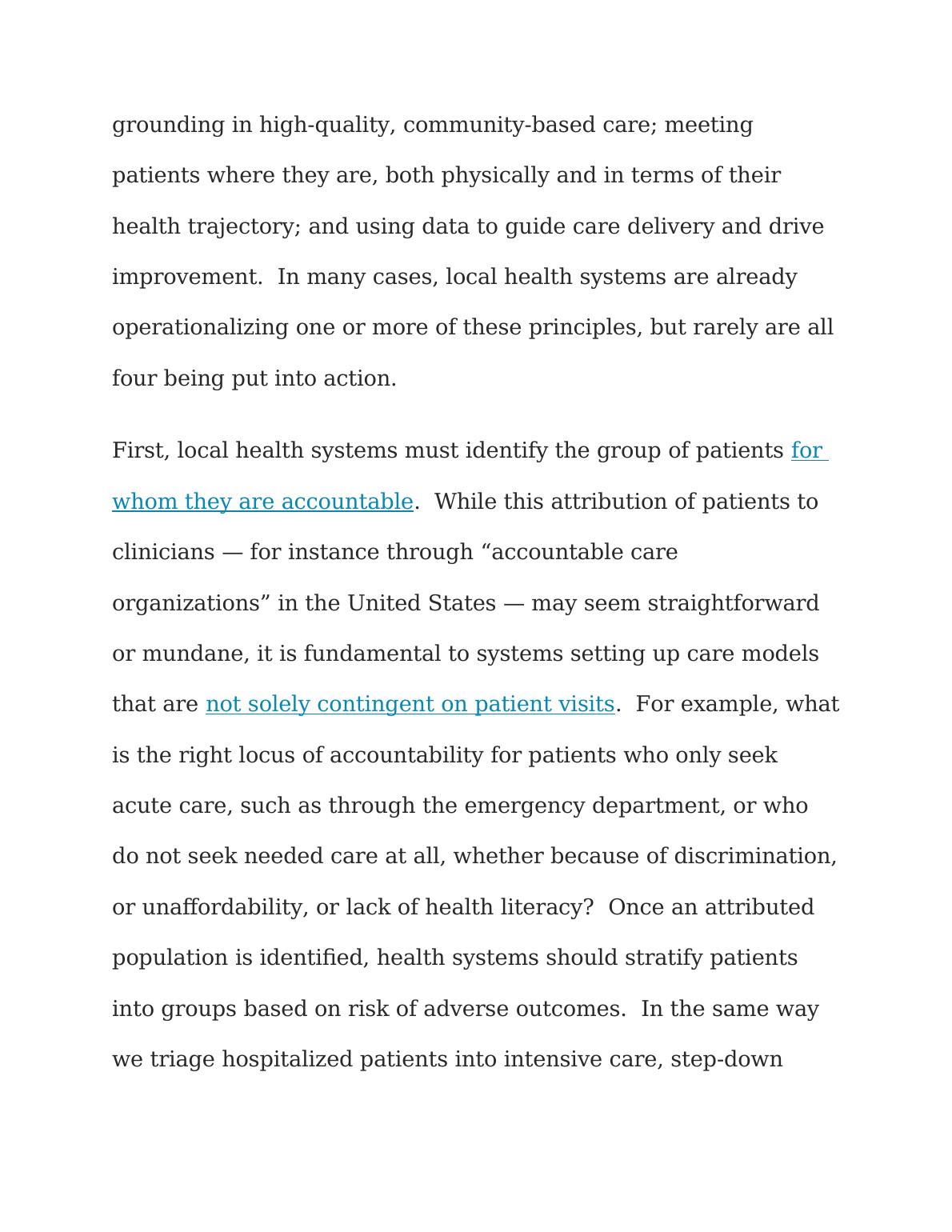4 Principles for Improving Health Care Around the World
Added on 2022-08-08
10 Pages1673 Words22 Views
4 Principles for Improving Health Care
Around the World
Dave A. Chokshi
Convergent evolution occurs when similar environmental
pressures produce similar adaptations in organisms from different
evolutionary lineages. For example, the wings of insects, birds,
and bats are similar in structure and share the same function —
but evolved independently. In the same way, changes occurring
among health systems across the world can be viewed through
the lens of convergent evolution.
The environmental pressures shaping health system design
span shifting pathologies and shifting political priorities. Between
1990 and 2016, noncommunicable diseases such as cancers and
mental illness became the greatest cause of disease burden
worldwide, as measured by disability-adjusted life years, a trend
likely to continue due to aging populations. Growing
evidence demonstrates that social determinants of health, such as
housing and education, are at least as important as medical
services in generating health outcomes. At the same time,
Around the World
Dave A. Chokshi
Convergent evolution occurs when similar environmental
pressures produce similar adaptations in organisms from different
evolutionary lineages. For example, the wings of insects, birds,
and bats are similar in structure and share the same function —
but evolved independently. In the same way, changes occurring
among health systems across the world can be viewed through
the lens of convergent evolution.
The environmental pressures shaping health system design
span shifting pathologies and shifting political priorities. Between
1990 and 2016, noncommunicable diseases such as cancers and
mental illness became the greatest cause of disease burden
worldwide, as measured by disability-adjusted life years, a trend
likely to continue due to aging populations. Growing
evidence demonstrates that social determinants of health, such as
housing and education, are at least as important as medical
services in generating health outcomes. At the same time,

financing for health is moving from paying for services rendered
to channeling spending according to effectiveness in improving
outcomes. Finally, a commitment to universal health
coverage (UHC) — individuals and communities receiving the
health services they need without suffering financial hardship —
has gained momentum, with all United Nations member
states pursuing UHC by 2030 as part of the Sustainable
Development Goals.
Global Principles
These common evolutionary pressures shape system design
choices in the United States and around the world.
Commonalities in problems encountered suggest that solutions —
or at least principles underlying those solutions — may also be
generalizable. At NYC Health + Hospitals, the largest public
healthcare system in the United States, I have helped architect a
strategy around population health, defined as a more proactive
approach to addressing avoidable human suffering. Four
principles undergird the strategy: identifying and stratifying an
attributed population (i.e., the population they’re responsible for);
to channeling spending according to effectiveness in improving
outcomes. Finally, a commitment to universal health
coverage (UHC) — individuals and communities receiving the
health services they need without suffering financial hardship —
has gained momentum, with all United Nations member
states pursuing UHC by 2030 as part of the Sustainable
Development Goals.
Global Principles
These common evolutionary pressures shape system design
choices in the United States and around the world.
Commonalities in problems encountered suggest that solutions —
or at least principles underlying those solutions — may also be
generalizable. At NYC Health + Hospitals, the largest public
healthcare system in the United States, I have helped architect a
strategy around population health, defined as a more proactive
approach to addressing avoidable human suffering. Four
principles undergird the strategy: identifying and stratifying an
attributed population (i.e., the population they’re responsible for);

grounding in high-quality, community-based care; meeting
patients where they are, both physically and in terms of their
health trajectory; and using data to guide care delivery and drive
improvement. In many cases, local health systems are already
operationalizing one or more of these principles, but rarely are all
four being put into action.
First, local health systems must identify the group of patients for
whom they are accountable. While this attribution of patients to
clinicians — for instance through “accountable care
organizations” in the United States — may seem straightforward
or mundane, it is fundamental to systems setting up care models
that are not solely contingent on patient visits. For example, what
is the right locus of accountability for patients who only seek
acute care, such as through the emergency department, or who
do not seek needed care at all, whether because of discrimination,
or unaffordability, or lack of health literacy? Once an attributed
population is identified, health systems should stratify patients
into groups based on risk of adverse outcomes. In the same way
we triage hospitalized patients into intensive care, step-down
patients where they are, both physically and in terms of their
health trajectory; and using data to guide care delivery and drive
improvement. In many cases, local health systems are already
operationalizing one or more of these principles, but rarely are all
four being put into action.
First, local health systems must identify the group of patients for
whom they are accountable. While this attribution of patients to
clinicians — for instance through “accountable care
organizations” in the United States — may seem straightforward
or mundane, it is fundamental to systems setting up care models
that are not solely contingent on patient visits. For example, what
is the right locus of accountability for patients who only seek
acute care, such as through the emergency department, or who
do not seek needed care at all, whether because of discrimination,
or unaffordability, or lack of health literacy? Once an attributed
population is identified, health systems should stratify patients
into groups based on risk of adverse outcomes. In the same way
we triage hospitalized patients into intensive care, step-down

End of preview
Want to access all the pages? Upload your documents or become a member.
Related Documents
The Importance of Nurse Staffing Ratio and the Role of Nurse Leaderslg...
|8
|1759
|221
A Review of Victorian Health Care Deficitslg...
|28
|8071
|253
